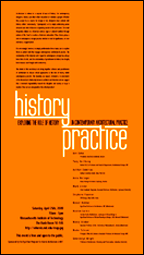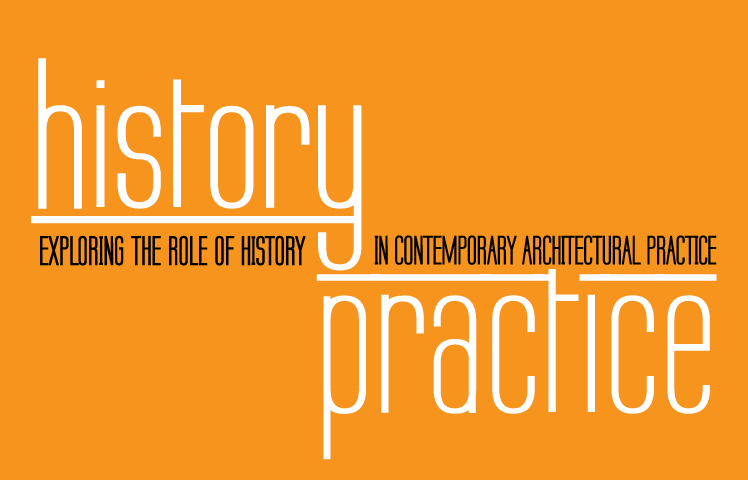Saturday
April 25th, 2009
10:00 am – 5:30 pm
The Bush Room
(map) MIT 10-105
Event is free and
open to the public
Organized by
Christian Hedrick
AKPIA@MIT
PhD
&
Zameer Basrai
AKPIA@MIT
SMArchS
Program pdf


|
|
Architecture is witness to a myriad of uses of history. For contemporary designers, history can often either encumber or validate a project. Whether they accept it as a source for design or not, designers must contend with history, either ‘contextually,’ ‘typologically’ or by simply addressing patron demands and other influences originating outside of the profession. The result frequently alludes to a historical context, type or cultural tradition through notions of the ‘local or evokes a historical antecedent. Thus, history plays a role in contemporary design practice whether or not its significance, or even relevance, is appreciated.
It is not enough, however, to simply problematize these issues, but to explore them as potent tools that engage contemporary architectural practice. The relationship of the historian with regard to contemporary design has always been that of critic, and the relationship of practitioner to history has largely been tenuous and fraught with controversy.
The intent of this workshop is to bring together scholars and practitioners of architecture to discuss critical approaches to the role of history within contemporary practice. The situation, we suspect, demands a re-assessment of the theoretical relationship between architect and historian and we suggest that a renewed responsibility toward the discipline and society at large is needed. How can we conceptualize this critical practice?
PARTICIPANTS:
Ann Beha
President, Ann Beha Architects, Boston
Yung Ho Chang
Atelier FCJZ & Professor and Head of Department, Architectural Design, MIT
Aslihan Demirtas
Aslihan Demirtas Studio, New York City
Anna Heringer
Anna Heringer Architect, Salzburg, Austria
Mark Linder
Chair Graduate Programs, Associate Prof, Architecture, Syracuse University
Stephane Paumier
SPA Design, New Delhi, India
Nasser Rabbat
Aga Khan Professor of Islamic Architecture, MIT
A. Hashim Sarkis
Hashim Sarkis Architecture, Landscape & Urban Design &
Aga Khan Professor of Urban Planning & Design, GSD, Harvard
Nancy Stieber
Associate Professor of Art, University of Massachusetts, Boston
Nader Tehrani
Principal, Office dA, Boston & Associate Professor, Architectural Design, MIT
Gwendolyn Wright
Professor of Architecture, Planning and Preservation, Columbia University
|
|
|
BIOGRAPHIES
Ann Beha (top)
Ann Beha FAIA of AnnBeha Architects, received her Master of Architecture degree at MIT, was a Loeb Fellow at Harvard’s Graduate School of Design, and has an undergraduate degree in American history from Wellesley College.Her firm works nationally and internationally for cultural, academic, and civic clients, with a focus on the re-envisioning of historic and significant buildings, deploying them for new uses, and recasting their public identity. AnnBeha Architects investigates clearly contemporary forms in dialogue with historic precedents. Their projects have been widely published and received awards for design and for preservation of cultural resources. Currently Ann Beha is leading projects for Princeton, The University of Pennsylvania, and the Museum of Fine Arts in Boston, as well as numerous museums and civic organizations, and her firm is also undertaking cultural planning work and design work in Lahore Pakistan.
Yung Ho Chang (top)
Yung Ho Chang, Professor of Architecture and Head of the Department of Architecture, comes to MIT from Peking University where he was Head and Professor of the Graduate Center of Architecture. He received his MArch from the University of California at Berkeley and taught in the US for 15 years before returning to Beijing to establish China’s first private architecture firm, Atelier FCJZ. He has exhibited internationally as an artist as well as architect and is widely published, including the monograph Yung Ho Chang/Atelier Feichang Jianzhu: A Chinese Practice. His interdisciplinary research focuses on the city, materiality, and tradition. He often combines his research activities with design commissions.
Aslihan Demirtas (top)
Aslihan Demirtas holds a Master of Science in Architectural Studies from Massachusetts Institute of Technology and a Bachelor of Architecture from the Middle East Technical University, Turkey. She is a practicing architect since 1991 and has worked with, among many, I.M. Pei as his lead architectural designer for international projects such as the Museum of Islamic Art, Doha, Qatar and Miho Chapel, Kyoto, Japan. In 2007, she established her own practice in Brooklyn, New York and has been working on local and international projects.As part of her research, Aslihan Demirtas has been studying architecture as part of a wider interdisciplinary understanding of building activity inclusive of landscape and infrastructure and ecology. Her research has been generously supported by the The Aga Khan Program for Islamic Architecture. She has published in journals and books such as Thresholds and ANYTIME and has written a chapter in the forthcoming book Landscapes of Development from Harvard Press. As architecture design critic, Aslihan Demirtas is currently teaching design studio at Parsons School of Constructed Environments and has taught at MIT, RISD, City College of New York and NJIT and lectured in GSD at Harvard University and Bauhaus University in Weimar, Germany.
Anna Heringer (top)
Architect, visiting professor BASEhabitat/ University of Art Linz, Austria. Born 1977 in Germany, Anna Heringer studied architecture at the University of Art Linz in Austria (1999–2004). She realized several building projects in Bangladesh that were rewarded with the Aga Khan Award for Architecture (10th circle), the AR Emerging Architecture Awards 2006 and 2008, the Archiprix – Hounter Douglas Award 2007, The 2007 Kenneth F. Brown Asia Pasific Culture And Architecture Design Award amongst other prizes. As visiting professor she is currently building up the project studio BASEhabitat – architecture for developing countries at the University of Art Linz. She has been involved in rural development work with the NGOs Shanti and Dipshikha since 1997.
Mark Linder (top)
Mark Linder, is currently an Associate Professor of Architecture and Chairman of the Graduate Program at the Syracuse University School of Architecture. Linder received his Bachelor of Science in Architecture from the University of Virginia in 1982, then went on to receive his Master of Architecture degree and a Master of Environmental Design degree (MED) from Yale University in 1986. Linder also received a Ph.D in architecture from Princeton University in 1998. At Syracuse, Linder teaches architectural design and theory in addition to his own practice, CLear, based in Syracuse, New York. Linder has also written numerous publications, his most recent book, published in 2004 is called Nothing Less Than Literal: Architecture After Minimalism.
Stephane Paumier (top)
Stephane Paumier was born in Versailles, France in 1971. After completing his baccalaureat in Ecole Estienne in Applied Arts, he studied industrial design at the National School of Applied Arts and Crafts (Olivier de Serres) and Architecture at the School of Architecture of Paris-Belleville, under Professor Henri Ciriani.
He came to India in 1996 under the French civil service programme to renovate the French Embassy in Delhi, he stayed further and setup a studio in 1999 with ABRD architects to build the French Institute of Pondicherry and the Alliance Francaise of Delhi. In 2005 he founded SPA Design Pvt.Ltd. an India based architectural practicwase that focus on developing contextual skills for each project. Stephane Paumier has been awarded the A+D Young Architect Award in 2003 and 2004 and the Silver Medal of Architecture by the French Academy of Architecture in 2005. He is now in charge of the OPJindal Global University project, a 150 000 sqm programme in Sonepat, Haryana.
Nasser Rabbat (top)
Nasser Rabbat is the Aga Khan Professor and Director of the Aga Khan Program for Islamic Architecture at MIT. He studies the history, historiography, and criticism of Islamic architecture, urbanism, and cultures. His books include: The Citadel of Cairo: A New Interpretation of Royal Mamluk Architecture (1995), Thaqafat al Bina’ wa Bina’ al-Thaqafa (The Culture of Building and Building Culture) (2002), and L’art Islamique à la recherche d’une méthode historique (2009). Forthcoming are two books in Arabic, al-Mudun al-Mayita fi Suriya (Dead Cities in Syria) (2009), al-Naqd Iltizaman (Criticism as Commitment) (2010) and two in English Architecture As Social History: Building, Culture, and Politics in Mamluk Egypt and Syria (Tauris, 2010) and an edited book, The Courtyard House between Cultural Reference and Universal Relevance (Ashgate, 2010).
A. Hashim Sarkis (top)
Hashim Sarkis is the Aga Khan Professor of Landscape Architecture and Urbanism in Muslim Societies. He teaches courses in the history and theory of architecture, such as Practices in Democracy, Constructing Vision: A History and Theory of Perspective’s Applications in Architecture, Developing Worlds: Planning and Design in the Middle East and Latin America After WWII, and Green Modern: A History of Environmental Consciousness in Architecture from Patrick Geddes to the Present, and design studios: The Architecture of Geography: Istanbul, Mixed-Use Development, and the Panoramic Condition; Makina/Madina: Reconfiguring the Relationship Between Geography and Event in the City of Fez; Intermodal Istanbul; Square One: Martyrs’ Square, Downtown Beirut, Lebanon; and A Field of Schools: Rethinking the Relationship between School and City in San Diego.
Sarkis is a practicing architect between Cambridge and Lebanon. His projects include a housing complex for the fishermen of Tyre, a park in downtown Beirut, two schools in the North Lebanon region, and several urban and landscape projects.
He is author of several books and articles including Circa 1958: Lebanon in the Pictures and Plans of Constantinos Doxiadis (Beirut: Dar Annahar, 2003), editor of CASE: Le Corbusier’s Venice Hospital (Munich: Prestel, 2001), co-editor with Peter G. Rowe of Projecting Beirut (Munich: Prestel, 1998), and executive editor of the CASE publication series (GSD/Prestel). Sarkis directs the Aga Khan Program of Activities at the GSD. From 2002-2005 he was also Director of the Master of Design Studies Program (MDes) and the Doctorate of Design (DDes) program. He received his BArch and BFA from the Rhode Island School of Design, his MArch from the GSD, and his PhD in architecture from Harvard University.
Nancy Stieber (top)
Nancy Stieber is an associate professor in the Art Department of the University of Massachusetts/Boston where she teaches architectural history. Specialized in the history of housing and urbanism of the twentieth century in the Netherlands, her current research examines the ways in which the city of Amsterdam was represented in a variety of media at the turn of the century. Editor of the Journal of the Society of Architecural Historians from 2002-06, she was recipient of a fellowships from the Radcliffe Institute for Advanced Study in 2000-01, the National Endowment for the Humanities in 2006-07 and the Netherlands Institute for Advanced Study in 2008.
Nader Tehrani (top)
received a Bachelor of Fine Arts and a Bachelor in Architecture from the Rhode Island School of Design in 1985 and 1986 respectively. He continued his studies at the Harvard Graduate School of Design where he received a Masters of Architecture in Urban Design in 1991. Tehrani attended a post-graduate program in History and Theory at the Architectural Association in London. A tenured Associate Professor of Architecture at Massachusetts Institute of Technology, Tehrani has also taught at the Harvard Graduate School of Design, Rhode Island School of Design, and Georgia Institute of Technology, where he served as the Thomas W. Ventulett III Distinguished Chair in Architectural Design.
In the academic context, Nader Tehrani has focused on research surrounding materials, methods of aggregations, geometry and the advancement of digital fabrication. His participation in the Immaterial/Ultra-material Exhibition at the GSD is paralleled by his installations at the Museum of Modern Art, the Institute of Contemporary Art in Boston, and the Georgia Institute of Technology, investigating new means and methods of fabrication in wood, steel, rope and polycarbonate. In the professional context, Nader Tehrani is a principal at Office dA, where he has received numerous international awards, including ten Progressive Architecture awards, 5 I.D. Magazine Awards, the Harleston Parker Award, an Academy Award from the American Academy of Arts and Letters, as well as the Cooper-Hewitt National Design Award for Architecture. Work of Office dA includes the Rhode Island School of Design Library, the Northeastern University Spiritual Life Center, the renovation of the Harvard Graduate School of Design offices, as well as numerous restaurants. The firm’s work in green design includes Helios House, a sustainable power station in Los Angeles, and the Macallen Buiding, a 144 unit, LEED Gold certified condominium building in Boston. Office dA has also worked on such international projects as the Tongxian Arts Center in Beijing, the Elemental community project in Chile, and the Villa Moda Competition in Kuwait.
Gwendolyn Wright (top)
Gwendolyn Wright is a Professor of Architecture and History at Columbia University. Her most recent book is USA (2008) in Reaktion’s Modern Architectures in History series. Her five books and numerous articles have explored distinctive aspects of American modernism, the history of American housing, modern urbanism and historic preservation in French colonies and other issues that challenge architects to think about their practice in new ways.
|


